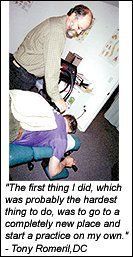You became a chiropractor to serve people, not an insurance company. You deserve to run a business that aligns with your values, supports your family and lights you up. Cash-based care isn’t just a pricing model – it’s a philosophy rooted in freedom, trust and respect for your patients and for yourself. Here's why - and how - to do it.
Three Alaskan DCs Share Their Stories
I recently traveled to Alaska to spend a few weeks talking with chiropractors about their practices, patients and problems. I was taking the pulse, so to speak, of our collective chiropractic community. I discovered why these doctors are successful in chiropractic, not only for their perseverance under adversity, but because of their collective belief in a relatively simple ideal: Chiropractic gets sick people well.

Dr. E.E. "Woody" Waldroup: A Singer of Songs
Anchorage, Alaska, chiropractor Dr. E.E. "Woody" Waldroup - aka Woody Wills - remembers the moment when he found his chiropractic purpose in life.

"I realized in that moment that, basically, I was a singer," says Dr. Waldroup. "A very important part of what I was doing with this singing for the last 30 years is simply sharing to a community, not unlike sharing what's coming out of the chiropractic community, and expressing it when I meet people, so regular folks can understand it."
In chiropractic, he found the means to be true to his beliefs. "To me, it was a way of holding on to some very important parts of my ideals," he says. "Frankly, those of us who go into chiropractic have at least some streak of the rebel, just like the cowboy."
Dr. Waldroup was born in Pueblo, Colorado, and raised on a cattle ranch outside nearby Trinidad in the small town of Branson. After graduation, he joined the Navy and started to study the guitar in his spare time. Unable at first to find a guitar he could use, since he is left-handed, he practiced on a right-handed guitar, upside down. He began writing songs and soon went to a California recording studio and cut his first song demo, "Black Glove." After tragically losing two members of his band to an auto accident, he chose to move to Alaska. Woody married Sandie, who had moved to the state to homestead with her family. They were soon blessed with children Jesse, Heather and Jennifer.

Suffering a back injury brought Dr. Waldroup in contact with chiropractic. He was so impressed with the results chiropractic brought him, he soon attended Palmer College of Chiropractic in Davenport, Iowa. "Because I had such amazing results, I realized that there was really something amazing going on. So, I looked into it further and decided to become trained to help other people," he says.
After receiving his degree, he returned to Anchorage, where he still has his chiropractic office today. Sandie Waldroup, Woody's wife and office manager, says he has a "heart of gold and hands that heal." She says his involvement in the community provides the bonus of helping people learn more about the benefits of chiropractic. "He gives away more than he's ever gotten," she pronounces. Woody is always there for his patients, and when they have needed it, he has provided pro bono care in a quiet and gracious way that so many in his community admire.
"As the years have gone by, we have built a backlog of former patients who continue to come as they need it," Dr. Waldroup says. "We have got many second and third generations of families now coming in from when I first began. They continue to send and bring their children and grandkids. One daughter is attending chiropractic school and shall return to serve the Alaska community."

Woody Waldroup's success as a chiropractor led to more accomplishments as a musician, allowing him to record albums in Nashville, and as a humanitarian, when he recently joined 31 other country musicians in Belgium for a benefit concert for a child in need of a surgery that was not available to him in his country. Today, he is helping to forge a different kind of change within his profession. This is a chiropractic revolution that goes beyond politics, to the way people live their lives and take care of their bodies, and the inherent harmony that comes from understanding the link between body, mind and spirit.
"The best advice I can pass on to a young chiropractic doctor is to continue to tell the chiropractic story," advises Dr. Waldroup. "I've been doing that since 1976, and it works because I still think the sick person is looking for an alternative method to healing. When in doubt, adjust. Also, remember it is important to support your profession, its society and its chapters; without them, you would not be here."
Dr. William O. West: A Fisherman among Men
Soldotna, AK, chiropractor Dr. William O. West remembers the moment when he found his chiropractic purpose in life. The opening day of his practice was the day that Elvis died. "I knew that it would be hard that day," Dr. West recalls. "I didn't have any x-ray equipment yet, so I asked the local hospital if they would take my patients' x-rays. They refused! Today, they seek me out to order MRIs at their facility. Now these hospitals are vying for my chiropractic patients!"
Dr. West says small-town life has its advantages. "I walk down the streets here and see people I know, and who know me. In a large city, everyone is running and they never know who you are. The older people and their families I've had all these years, they've come to know that I'm here, and they still come and refer others."
In the years since he decided to make the academic trek to Davenport, Iowa, and Palmer College, he has built a career at the Peninsula Chiropractic Clinic that sits near the banks of the world-famous Kenai River, located just a short stroll from the city of Soldotna; a city where during the winter months, the dog mushers tie up to West's clinic sign outside before being adjusted.
Dr. West was encouraged to attend chiropractic school when the brother of a friend gave up a profitable electrical construction business to become a DC. He came to Alaska during the building of the Alaskan pipeline, when a local DC needed a new associate.
"For the first two years I was an associate," West recalls. "It's a great way to start out. You have no real overhead. No burden of running the practice or managing the practice, and you can learn a great deal. There is a lot more to running a clinic than what you learn in school. Now I own my own corporation, and the building."
Today, Dr. West's practice keeps him busy, and he admits that he seldom takes time out to fish during lunch anymore. Still, the legacy he created in the landing of the rockfish on the Kenai's banks has not been forgotten.
Dr. West's advice for young doctors attempting to build a practice? "Tell the chiropractic story with sincerity and dedication." He adds: "Don't expect to get wealthy in chiropractic, but always remember that your patients will support you. You need to be ready to work hard for what you do. Trust your ability and your instinct."
On the question of retirement, Dr. West points out he's in good health. "What would I do if I quit? I love this work. I feel that there is still a need, and that's where I want to be. I have no plans for retirement." Expressing many chiropractors' sentiments, he proclaimed, "They will have to carry me out."
Dr. Tony Romeril: Improving Patient Care through Education

Homer, AK, chiropractor Dr. Tony Romeril remembers the moment when he found his chiropractic purpose in life. Early on, prior to becoming a DC, Dr. Romeril found himself working as an intraoperative-evoked-potential and polysomnography technologist in a neurology department at a hospital in Honolulu, Hawaii. There his duties included intraoperative-evoked-potential testing and clinical EEG testing, in which he worked closely alongside medical physicians on intraoperative procedures. Although he applied to medical school, he decided upon the alternative in health care: chiropractic.
Today, Dr. Romeril excels in making the principles and practices of his own profession clear not only to the public, but also to the medical community, which is "desperately in need of enlightenment on chiropractic," he says.
In 1999, Dr. Romeril graduated summa cum laude from Logan College of Chiropractic in Chesterfield, Missouri, following his completion of a master of science degree in neuroscience at the University of British Columbia, in Vancouver. Dr. Romeril describes how he found himself in Alaska: "It was a salmon fishing trip that brought me to Alaska and that created the opening of Back to Action Chiropractic & Wellspring Apothecary in Homer, Alaska."
Today, he teaches biology, chemistry and physics for the local branch of the University of Alaska, Anchorage while maintaining a full-time practice. He is certified in water and industrial safety programs and CPR, and holds a student's pilot license. Within the community, he has also been active on the softball, basketball and floor-hockey teams.
Homer is a small maritime community of roughly 4,000 in the rolling hills and ridges overlooking Kachemak Bay, located at the southwest end of the Kenai Peninsula where Cook Inlet meets the Gulf of Alaska. Bears, wolves and moose roam the uplands, and hundreds of thousands of birds of a dozen different species gather each spring to feed on the mudflats at the head of the bay.
"The first thing I did, which was probably the hardest thing to do, was to go to a completely new place and start a practice on my own," Dr. Romeril remembers. "The first year or two, I spent a lot of time doing speaking engagements and doing a lot of marketing, trying to spread the word about chiropractic. Eventually, as more people started getting phenomenal results, the word just spread. Now, my practice grows through word-of-mouth referrals."

Dr. Romeril commented on the difficult transition from student to practicing chiropractor: "School trains you to practice a health care procedure, but as far as the business and administrative aspects - all the details of setting up a practice and getting patients in the door - you have to figure it out on your own." He also stresses the importance of educating patients about the benefits of chiropractic.
His clinic stays open year-round. "The community becomes just as busy in the winter with the snow and ice dangers," he explains. "I treat a lot of slips and falls and cumulative lifting injuries, such as [from] lifting the snowmobiles. In the summer, I treat a lot of slips and falls due to the high tourism and recreational activities, and the cumulative lifting injuries of commercial fishermen. And with the shorter hours of light in the winter, it seems that my patients appear more alert to any feelings of ill-being that best respond to chiropractic."
Dr. Romeril's office is rooted in providing quality chiropractic care. "We tell our patients after they've gotten their problem under control, that when [it] begins to flare up, to come back in a month or two, just to keep it in check. That's worked, and continues to work."
Chiropractors are truly the same. Whether a singer, a fisherman or an educator, we are one. We must continue to rise to the challenges, for both our patients and ourselves, to be the best in chiropractic.
Special thanks go to these fine colleagues who have kept up the fight and excelled within their local communities.
Nancy Molina,DC
San Juan Capistrano, California



